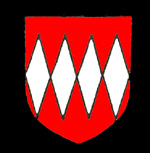The Manor of Kempston Daubeney

The Daubeney family arms
Volume III of The Victoria County History for Bedfordshire was published in 1912 and contains histories of each of the manors in Kempston. In 1237 John le Scot, Lord of the Manor of Kempston died and, following the death of his widow and a spell in royal hands in 1254 whilst agreement on the division could be sought, the manor was divided between his three sisters.
The Manor of Kempston Daubeney, as it came to be known, was the inheritance of Scot’s eldest sister Margaret, wife of Alan, Lord Galloway. On her death it passed to her daughter Devorgilla, wife of John de Balliol. After her death she was succeeded by her son John, who was acknowledged as King of Scotland in 1292 but forfeited the crown in 1296 for rebelling against his overlord, King Edward I of England (1272-1307). Because of this Edward seized the manor and given by Edward to his nephew John de Brittany, Earl of Richmond in 1306. From 1327 William Glaykyn leased the manor from the earl but by 1333 William Daubeney obtained reversion of the manor and entered into possession on the death of the Earl of Richmond in 1334. In 1337 he obtained a grant of the manor for himself and his heirs.
In 1357 William conveyed the manor to Sir Giles Daubeney of South Petherton [Somerset]. The manor then descended in the Daubeney family until 1483 when Giles Daubeney took part in the Duke of Buckingham’s attempt to supplant Richard III (1483-1485) with the Earl of Richmond and he had to flee to Brittany, his lands being confiscated. Daubeney Manor was then given to Sir John Egremont in 1484 but when Richmond acceded to the throne as Henry VII (1485-1509) after killing Richard III at Bosworth Field, Daubeney was restored to his lands and even made a baron in 1486. He served Henry as Master of the Mint and then Lieutenant of Calais in 1486, during the tenure of which he conducted campaigns against the French. He was appointed Lord Chamberlain in 1495. He was captured by Cornish rebels he was sent to crush in 1497 but soon released by them. He died in 1508 and was buried in Westminster Abbey.

The Bray family arms
In 1502 the 1st Baron Daubeney conveyed the manor to Sir Reginald Bray, who also held the Manor of Eaton Bray. The manor remained in the Bray family until alienated in 1569 to Thomas Snagge of Marston Moretaine, Speaker of the House of Commons in 1588 and 1589. His son, also Thomas, was High Sheriff of Bedfordshire and member of parliament for the county.
The manor then passed down through the Snagge family until 1659 when it was alienated to Robert Yarway, who conveyed it to Matthew Dennis in 1660. Dennis left two daughters who obviously alienated the manor to their uncle as he was Lord of the Manor from 1710 to 1745, his son inheriting.
In 1813 Robert Dennis sold the manor Rev. Edmund Riland Williamson in whose family it remained into the 20th century. A succession of Law of Property Acts in the 1920s extinguished all manorial incidents, courts and copyhold tenure of land. This effectively abolished manors in all but name.